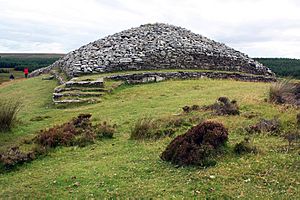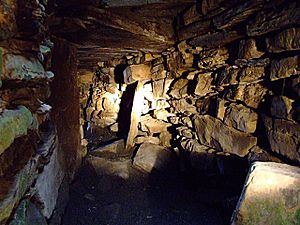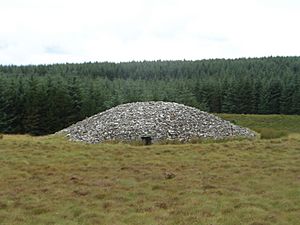Grey Cairns of Camster facts for kids
The Grey Cairns of Camster are two very old stone structures in Scotland. They are called chambered cairns, which are like ancient tombs or burial mounds. These cairns were built by people living in the Neolithic period, which was about 5,000 years ago! That makes them some of the oldest buildings in Scotland.
The cairns have special rooms inside, called burial chambers. You can reach these rooms through narrow passages. In the late 1900s, experts from Historic Environment Scotland dug up and fixed these cairns. Now, you can visit them and even go inside!
Contents
Where are the Camster Cairns?
These amazing stone structures are found in a quiet, open area of Caithness, in the Highland region of Scotland. They are about 14 kilometers (8.5 miles) south of Watten and 8 kilometers (5 miles) north of Lybster.
The area around the cairns is known as the Flow Country. Today, it's a boggy moorland covered in peat. But long, long ago, during the Stone Age, this land was good for farming. It only became covered in peat much later, during the Bronze Age.
The two main cairns are called Camster Round and Camster Long. They stand about 180 meters (590 feet) apart. There's also another smaller cairn nearby, but it's not usually counted as part of the main Camster group.
What Do the Cairns Look Like?
Camster Long: A Giant Stone Ship
Camster Long is a very long cairn, about 60 meters (197 feet) in length. It's shaped a bit like a giant ship or a long mound with "horns" at each end. It's wider at one end (about 20 meters or 66 feet) than the other (about 10 meters or 33 feet).
This cairn is tallest over its two burial chambers, reaching about 4.6 meters (15 feet) high. These chambers are about 15 meters (49 feet) apart. It seems that each chamber was first built inside its own round cairn. Later, for reasons we don't know, these two round cairns were joined together to make one long cairn.
You can get into both chambers through passages on the south-east side of the cairn.
- The west chamber has two parts, separated by tall stones that stand 2 meters (6.6 feet) high. When archaeologists dug here, they found human bones mixed with animal bones from horses, oxen, pigs, and deer.
- The east chamber has a passage that is 0.6 meters (2 feet) high and 7.5 meters (25 feet) long. The passage leads to a chamber shaped like an uneven five-sided room. Its roof is made of a single square stone, about 2 meters (6.6 feet) above the floor.
Camster Round: A Circular Tomb
As its name suggests, Camster Round is a circular cairn. It's about 18 meters (59 feet) across and 3.7 meters (12 feet) high. It looks a lot like what the original separate round cairns might have looked like before they were joined to make Camster Long.
This cairn is almost completely whole. It has a tall, arched chamber right in its middle. You can get to this chamber through a passage that is 6 meters (20 feet) long and 0.8 meters (2.6 feet) high. This passage is on the east-south-east side of the cairn.
It seems the passage was purposely blocked up with stones. When experts dug inside, they found a layer of black earth, ash, and burnt bones on the floor. It looks like bodies were placed there in a sitting position. Interestingly, many of the leg bones were missing. This might mean the legs were removed, or they simply decayed before the bodies were placed in the cairn.
Discovering the Past: Archaeology
People have been studying the Grey Cairns of Camster for a long time.
- The first big digs happened between 1865 and 1866. Two men, Joseph Anderson and Robert Shearer, explored seven ancient tombs in Caithness, including both Camster cairns.
- Later, in the 1960s and 1970s, more detailed studies and conservation work took place. John Corcoran led some of these efforts, and then Lionel Masters continued the work from 1976 to 1980.
- The job of making sure the cairns were strong and safe for visitors finished in 1981. Thanks to all this work, we can still visit and learn from these amazing ancient structures today!




